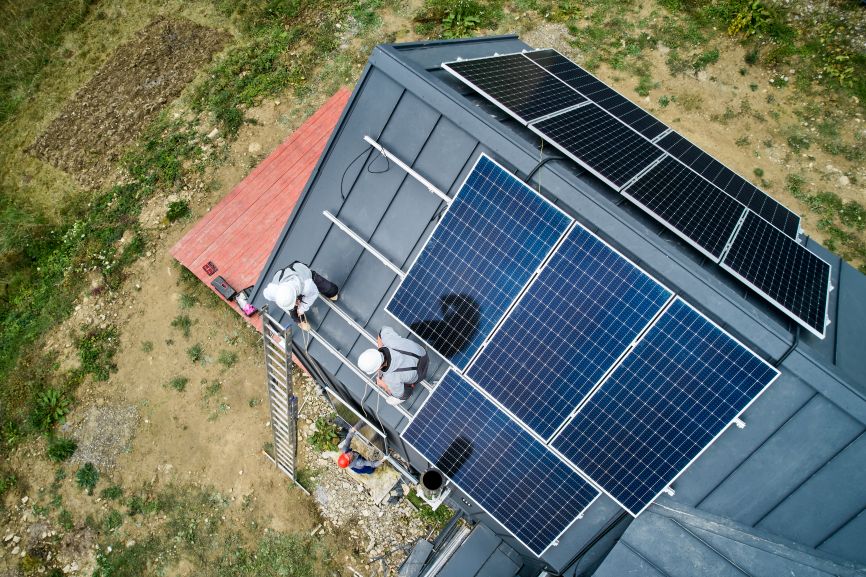On-Grid vs Off-Grid vs Hybrid Solar in Massachusetts (2025 Guide)
Massachusetts homeowners are feeling the squeeze—rising electric rates, storm-driven outages, and confusing choices about which on-grid vs off-grid path makes the most sense. This guide cuts through the noise with a clear, local look at options and where a hybrid solar system fits in for reliable backup and strong bill savings. We’ll translate Massachusetts solar incentives into plain English, outline real-world costs, and show practical upgrade paths (including converting an existing grid-tied array to battery backup). If you’d like tailored numbers, EcoSunWorks can match you with vetted MA installers for a free, no-pressure local quote. To start smart, let’s define the options so the rest of the guide clicks into place—first up: what is on-grid and off-grid solar?

What Is an On-Grid and Off-Grid Solar System?
Comparing solar options in Massachusetts? Start with clear definitions so you can choose with confidence:
- On-grid (grid-tied): Connected to your utility. Panels power your home first; shortfalls come from the grid. Excess can earn net-metering credits. Lowest upfront cost and strong ROI, but you’re still subject to outages unless you add batteries.
- Off-grid: Fully independent. Solar charges batteries that run your home day and night; an optional generator covers long cloudy spells. Higher upfront cost, maximum resilience and energy autonomy.
- Hybrid: Grid-connected with batteries—store daytime solar, ride through outages, and still benefit from net metering.
Next, we’ll unpack on-grid systems in Massachusetts—how they work, when they pay back fastest, and what installation involves.
On-Grid (Grid-Tied) Solar System Explained
An on-grid solar system—often called grid-tied solar—keeps your home connected to the utility. Your panels power the house first; any shortfall is covered by the grid, and any extra electricity flows out to the utility.
How the money piece works (Net Metering in Massachusetts): when your system produces more than you use, those surplus kWh create bill credits that reduce what you owe later. In plain English: sunny days bank value you can use at night or in winter. Eligibility and crediting rules are set by the state and your utility; for details, see the official Massachusetts Net Metering Guide.
When grid-tie is the best fit: you want the lowest upfront cost and fastest payback, you live in an area with reliable utility service, and you’re comfortable riding through brief outages without whole-home backup. (You can always add a battery later for critical circuits while keeping your net-metering benefits.)
About interconnection: before energizing, your installer files an interconnection application and obtains utility approval (Interconnection Service Agreement and Authorization to Connect). It’s a standard process your installer handles, but it must be completed to legally turn the system on.
Bottom line: grid-tied is the simplest, most cost-effective path to lower bills in Massachusetts—especially with net metering and other state incentives. Now, let’s place on-grid side-by-side with off-grid and hybrid so you can choose the setup that matches your resilience and savings goals.
Off-Grid Solar System Explained
If your goal is true energy independence in Massachusetts, an off-grid solar system cuts the cord to the utility and powers your home on your terms—delivering built-in blackout protection when storms hit.
What it includes (core components):
- PV array: rooftop or ground-mount panels sized to your annual/seasonal loads.
- Charge controller / hybrid inverter: converts DC→AC, manages charging, and “islands” safely during outages.
- Battery bank: modern LiFePO4 batteries offer high cycle life, deep discharge, and low maintenance.
- Optional generator: propane/natural gas unit to cover long, dark winter stretches and protect battery health.
- Critical-loads subpanel & BOS: keeps essentials—fridge, lights, internet, boiler controls—running efficiently.
Trade-offs to weigh: You’ll invest more upfront than grid-tied. Off-grid systems also demand load planning (efficient appliances, smart thermostats) and seasonal thinking—New England winters require either more battery/array capacity or a right-sized generator. There’s no net metering, so your system must meet your own demand profile rather than selling excess to the grid.
Realistic expectations: Design for 24–72 hours of autonomy on critical loads. Expect occasional generator runs in extended low-sun periods. With quality LiFePO4 storage and a properly sized array, maintenance is minimal and batteries can last a decade or more. The payoff is control: predictable energy, outage resilience, and long-term savings without utility rate hikes.
Want a reality-checked design for your property? EcoSunWorks connects you with vetted Massachusetts installers for a no-pressure, local proposal—so you see sizing, equipment, and timeline before you commit.
Next, let’s look at hybrid systems—a middle path that keeps the grid as a backup while you bank your own solar power.
Hybrid Solar Systems: Best of Both
A hybrid solar system pairs your panels with battery backup while staying connected to the grid. A grid-interactive inverter powers your home, charges the battery during the day, and automatically “islands” your essentials during an outage—so the lights stay on and the fridge keeps running. When the sun is strong, you can still earn net-metering credits; when it’s not, the grid stands by as a safety net.
For most suburban Massachusetts homes, this is the sweet spot: real outage protection without going fully off-grid, plus steady bill savings from solar production and credits. As consumer guides like EnergySage point out, hybrids deliver practical resilience and everyday value in one package.
A quick reality check: hybrids cost more than simple grid-tied systems (batteries and advanced inverters aren’t free), and there’s a small round-trip efficiency loss when storing energy. But for many MA homeowners who want both savings and peace of mind, the trade-off is worth it.
Want a right-sized hybrid design for your address? EcoSunWorks can line up local, no-pressure quotes.
Next, let’s compare on-grid vs off-grid vs hybrid side-by-side so you can choose with clarity.
On-Grid vs Off-Grid vs Hybrid: Side-by-Side

Choosing between systems comes down to how you value resilience, payback, and simplicity. Here’s a clear on grid vs off grid vs hybrid comparison that surfaces real-world pros and cons—including how net metering vs storage changes the math in Massachusetts.
Reliability during outages
- On-Grid: Goes down with the grid (unless you add batteries).
- Hybrid: Stays up for critical loads; battery backup rides through most outages.
- Off-Grid: Fully independent; designed to run during blackouts with batteries (and often a generator).
Bill savings
- On-Grid: Strong savings via net metering credits; best $/kWh when you don’t need backup.
- Hybrid: Savings from solar production + credits, plus strategic battery use (time-shifting and outage protection).
- Off-Grid: No electric bill when properly sized, but economics hinge on battery and generator fuel costs.
Upfront cost
- On-Grid: Lowest initial cost (no batteries).
- Hybrid: Medium—adds batteries and a grid-interactive inverter.
- Off-Grid: Highest—larger battery bank, possible generator, and balance-of-system upgrades.
Complexity
- On-Grid: Simplest design and interconnection.
- Hybrid: Moderate—battery integration, grid-interactive inverter, critical-loads subpanel.
- Off-Grid: Most complex—load planning, autonomy sizing, maintenance planning.
Maintenance
- On-Grid: Minimal (panels/inverter).
- Hybrid: Low to moderate (battery health checks, firmware).
- Off-Grid: Moderate—battery management and occasional generator service.
Typical homeowner fit in MA
- On-Grid: Suburbs with reliable utility service seeking fastest payback.
- Hybrid: Suburbs/towns where outages happen and homeowners want resilience without leaving net metering.
- Off-Grid: Rural or remote properties prioritizing independence over lowest upfront cost.
Bottom line (market reality)
- Most cost-effective: On-grid for pure bill reduction.
- Best balance: Hybrid for savings and backup (as many consumer guides note).
- Maximum autonomy: Off-grid for full independence and blackout protection.
If you already own a grid-tied array, the next smart question is how to upgrade: convert on-grid to hybrid or off-grid. Let’s walk through the practical paths and what to expect.
How to Convert an On-Grid Solar System to Off-Grid (or Hybrid)
If you already have a grid-tied array and want backup—or full independence—here’s how to convert on-grid solar to off-grid (or convert grid-tied to hybrid) the right way.
- Assess loads & backup goals
Decide between whole-home backup or critical loads only (fridge, lights, Wi-Fi, boiler controls, sump pump, medical devices). Pull 12 months of bills to confirm daily kWh and identify peak demand. This defines battery size and inverter power. - Pick your path: AC coupling, DC coupling, or hybrid inverter replacement
- AC coupling: Keep your existing string/microinverter array and add a battery inverter that charges from AC. Fastest retrofit, great with microinverters; slightly lower round-trip efficiency.
- DC coupling: Route PV into a charge controller/hybrid inverter that charges batteries on DC before converting to AC. Higher efficiency and tighter control; usually requires rewiring.
- Replace with a hybrid inverter: Swap your current inverter for a grid-interactive hybrid that manages PV, battery backup, and grid. Cleanest all-in-one path for many homes.
- Size & select batteries
Target usable kWh to cover 24–48 hours of critical loads (more for rural/wooded sites). Prefer LiFePO4 batteries for long cycle life, deeper discharge, and low maintenance. Match continuous and surge kW to your biggest starting loads (e.g., well pump, furnace blower). - Design a critical-loads subpanel
Move essential circuits to a dedicated subpanel the system can “island.” This prevents non-essentials (oven, EV charger) from draining storage during outages and keeps wiring code-compliant. - Permits & interconnection changes
Coordinate with your local Authority Having Jurisdiction (AHJ) and utility. Updated interconnection paperwork, single-line diagrams, and inspections are required before energizing a new hybrid/off-grid configuration. - Install & test islanding/anti-islanding
Have a licensed electrician perform the install, then commission and test automatic transfer, battery charging behavior, and safe anti-islanding. Keep firmware up to date and verify monitoring.
Side note—generator input: Many hybrids accept a generator as an emergency source. Size it to your inverter specs, add proper transfer equipment, and test under load each season.
Done well, a conversion gives you resilient backup today and a path to deeper independence later. Before you spec equipment, let’s review Massachusetts incentives and rules so your design maximizes credits and stays compliant.
Massachusetts Incentives & Rules
Massachusetts stacks multiple incentives that directly shape payback—especially if you stay grid-connected.
Net Metering (bill credits): If your system makes more electricity than you use, those surplus kWh earn credits on your bill that you can apply later (night/winter). Net metering is available to customers of the state’s investor-owned utilities, with eligibility and crediting rules defined by the Commonwealth.
SMART Tariff (monthly payments): The Solar Massachusetts Renewable Target (SMART) program pays you a fixed incentive per kWh of solar production. It’s a declining-block tariff administered by Eversource, National Grid, and Unitil; most residential systems (<25 kW) receive monthly payments for up to 10 years, on top of any net-metering credits.
Massachusetts state tax credit: Homeowners can claim a 15% income-tax credit (capped at $1,000) for eligible residential solar. The cap and credit are set in state regulation and summarized by DSIRE, the national incentives database.
Federal Residential Clean Energy Credit (30%): The federal credit equals 30% of qualified clean-energy costs through 2032 (phasing down after). Battery storage also qualifies when it meets IRS criteria, allowing you to pair solar with backup and still claim the credit.
What this means for you: Grid-tied and hybrid systems can stack net-metering credits + SMART payments + state credit + 30% federal—a powerful combo that shortens payback for most MA homes while keeping outage options open with batteries.
Want to see these incentives modeled on your address with real equipment and pricing? EcoSunWorks can line up no-pressure quotes from vetted Massachusetts installers. Next, we’ll show you how to size your system—a quick way to estimate kW and battery hours for your goals.
Sizing Your System (Simple MA Method)
Use this quick, MA-tuned process to size a solar system in Massachusetts and plan backup hours with confidence.
1) Pull your bills → find daily kWh
Add 12 months of usage, then divide by 365. Example: 9,000 kWh/yr → 24.7 kWh/day.
2) Choose your target offset
- On-grid: 90–100% offset maximizes net metering value.
- Hybrid: Aim for similar offset, but decide what you’ll back up (critical loads vs whole-home).
- Off-grid: Size to your full load profile plus winter margin.
3) Convert usage to system size (kW)
Massachusetts averages ~4 peak sun hours (PSH) annually (more in summer, less in winter).
Use: kW ≈ annual kWh ÷ (365 × PSH × 0.75) (the 0.75 factor covers real-world losses).
Example: 9,000 ÷ (365 × 4.0 × 0.75) ≈ 8 kW.
Roof check: ~18–22 panels (350–450 W each), ~330–400 sq ft, adjusted for tilt/azimuth/shading.
4) Size battery hours for backup
Estimate critical loads (fridge, lights, Wi-Fi, boiler controls, sump).
Usable battery (kWh) ≈ critical-loads daily kWh × desired hours ÷ 24.
Example: 8 kWh/day of essentials for 36 hours → 12 kWh battery. Prefer LiFePO4 for long cycle life.
When you want precise modeling (site shading, winter derates, panel count, inverter choice, and a PVWatts-style run), EcoSunWorks will connect you with vetted MA installers for a no-pressure custom design.
Next, we’ll turn that system size into dollars: What It Costs in Massachusetts (2025 Snapshot) and how incentives compress payback.
What It Costs in Massachusetts (2025 Snapshot)
Typical installed price ($/W)
As of August 2025, the Massachusetts solar cost per watt averages ~$3.07/W. Recent quotes commonly fall in a wider band (about $2.30–$3.44/W) depending on roof, equipment, and installer.
Example totals (before & after 30% federal credit)
- 5 kW system at $3.07/W → $15,350 before credits; $10,745 after the federal solar tax credit 30%.
- 10 kW system at $3.07/W → $30,700 before credits; $21,490 after the federal credit.
(Your final net price can drop further with MA incentives like SMART and the state tax credit covered above.)
What shifts price
Roof pitch/height, re-roof needs, main-panel upgrades, choice of panels/inverter, battery adders, and labor/permits all push totals up or down. Mid-tier panels with a standard string or hybrid inverter typically price lower than premium modules + integrated batteries (hybrid). (Benchmark against the $/W range above.)
Payback (ballpark)
With strong net metering and the 30% federal credit, many MA homes see single-digit to low-teens years payback; SolarReviews’ Boston example shows ~9.6 years (cash purchase, no battery). Batteries add resilience but lengthen payback slightly.
Ready to turn size into an exact quote? EcoSunWorks can line up vetted Massachusetts installers for apples-to-apples proposals. Next, we’ll clear up common mistakes & myths so you avoid surprises.
Common Mistakes & Myths

Before you pick equipment, clear the landmines: a handful of bad assumptions can add months and thousands to a project. In Massachusetts, the fine print on net metering, interconnection, and permitting matters as much as panel wattage. Below, we debunk the biggest off-grid myths, hybrid myths, and net metering misconceptions so you design for real outages, real bills, and real code compliance—then we’ll roll into the FAQs to lock in your plan.
Off-grid myths
- “Off-grid = free forever.” You avoid utility bills, but batteries, generators, and maintenance still cost.
- “Any battery will do.” Undersized or low-cycle batteries shorten runtime and lifespan—size for winter loads.
Hybrid myths
- “Hybrid backs up the whole house.” By default it protects critical loads; whole-home backup needs larger inverters and more storage.
- “Batteries always save more.” They add resilience first; savings depend on usage and rate structure.
Net metering misconceptions
- “Credits are cash at retail.” Credits offset bills; values and rules vary—don’t assume one utility’s rate applies to all.
- “No need to worry about rules.” Interconnection limits and program caps affect eligibility.
Planning pitfalls
- Skipping permitting/interconnection steps.
- Ignoring roof/shade constraints when estimating production.
- Forgetting service upgrades (main panel, wiring) in budgets.
FAQs
Q1: What is on-grid and off-grid solar system?
An on-grid (grid-tied) system stays connected to your utility. Your panels power the home first; extra production earns net-metering credits you use later. An off-grid system is independent: solar charges batteries that run your home day and night, often with an optional generator for long cloudy stretches. Choose on-grid for the simplest savings; choose off-grid for maximum energy independence and blackout protection.
Q2: How do I convert an on-grid solar system to off-grid?
To convert on-grid solar to off-grid—or to a battery-backed hybrid—follow this sequence:
- Assess whole-home vs critical loads and confirm daily kWh.
- Pick a path: AC coupling, DC coupling, or replace your inverter with a hybrid model.
- Size usable kWh for 24–48 hours of critical loads; prefer LiFePO4 batteries.
- Add a critical-loads subpanel so essentials run during outages.
- Complete permits and interconnection updates with your AHJ/utility.
- Install and test automatic islanding with a licensed electrician.
See the How to Convert an On-Grid Solar System to Off-Grid (or Hybrid) section above for the full step-by-step.
Q3: What is on-grid, off-grid, and hybrid solar system?
Grid-tied vs off-grid vs hybrid in one line each:
- On-grid: Lowest upfront cost and fastest payback via net metering; no backup unless you add batteries.
- Off-grid: Highest autonomy with batteries (and often a generator); larger upfront and more planning.
- Hybrid: Grid-connected with batteries—net-metering savings plus outage resilience; mid-range cost.
If you want numbers for your address, EcoSunWorks can connect you with vetted Massachusetts installers for no-pressure, apples-to-apples quotes—next, here’s why local homeowners choose us.
Why Work With EcoSunWorks (MA)
How we help
EcoSunWorks pairs you with top-rated solar installers in Massachusetts—fast. We match your home, budget, and goals to the right equipment and local pros who know SMART, net metering, and permitting inside out. You get transparent pricing, timelines, and warranties shown side by side so you can choose with confidence and avoid sales pressure. Get a solar quote MA and see exactly what your payback looks like. Get a no-pressure, 2–3 quote comparison from vetted Massachusetts installers—call now or request a free design.
